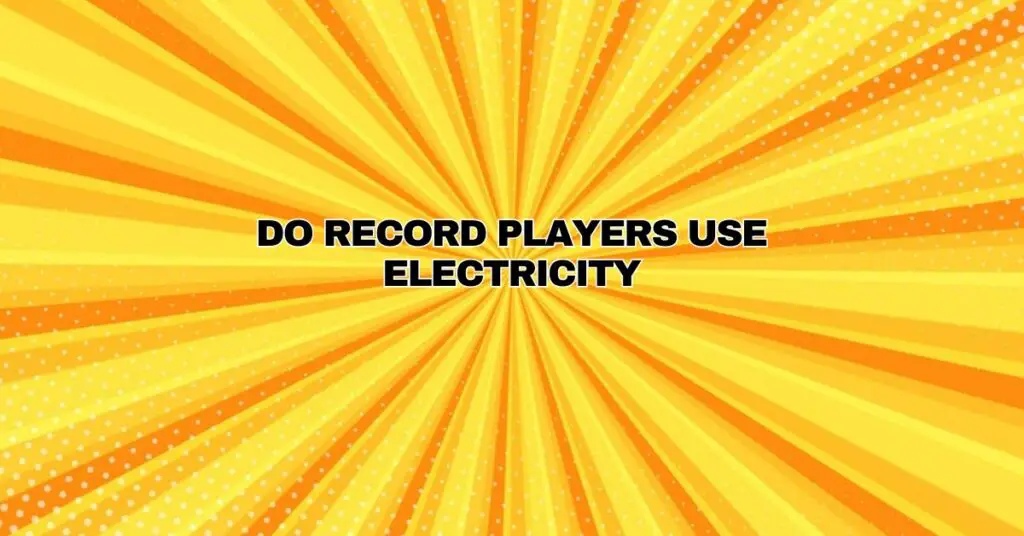Record players, also known as turntables, have been a cherished medium for playing vinyl records for decades. One common question that often arises is whether record players use electricity. In this comprehensive guide, we will explore the power sources of record players, the various components involved, and how they function to provide the timeless sound of analog music.
Part 1: Understanding Record Players
Before we delve into the power sources, it’s essential to understand the basic components and functionality of record players.
1.1 Key Components of a Record Player
- Turntable Platter: The turntable platter is where you place the vinyl record for playback. It rotates at a constant speed while the stylus (needle) tracks the grooves of the record.
- Tonearm: The tonearm is a pivotal component that holds the stylus. It is responsible for positioning the stylus on the record’s surface and ensuring it follows the grooves accurately.
- Stylus (Needle): The stylus, commonly referred to as the needle, is a small, diamond-tipped component that makes contact with the grooves on the vinyl record. It converts the physical movements in the grooves into electrical signals.
- Cartridge: The cartridge is a small housing that contains the stylus. It also houses a magnet and coils, which play a critical role in generating electrical signals from the stylus’s movements.
Part 2: Power Sources for Record Players
The power source for a record player primarily depends on its design and type. Here are the primary power sources for record players:
2.1 Manual (Hand-Cranked) Turntables
Some vintage or specialty turntables, such as those used in DJing or certain audiophile setups, operate manually. These record players do not use electricity but rely on a hand-cranked mechanism to rotate the platter. The user manually spins the turntable to play records.
2.2 Belt-Drive and Direct-Drive Turntables
Most modern record players, whether belt-drive or direct-drive, require electricity to function. Here’s how they work:
- Belt-Drive Turntables: These record players use a rubber belt to connect the motor to the platter. The motor runs on electricity, and when powered, it rotates the platter via the belt. The stylus then tracks the grooves, producing audio signals that are sent to an amplifier or speaker system.
- Direct-Drive Turntables: In direct-drive turntables, the motor is directly connected to the platter spindle. The motor is electrically powered and spins the platter at a consistent speed. The stylus’s movements on the vinyl record generate audio signals that are then amplified and sent to speakers.
Part 3: Electronic Components and Electricity
While record players use electricity to power their motors, it’s important to note that the primary function of electricity in a record player is to rotate the platter at the correct speed. The actual amplification and playback of audio signals do involve electricity, but it’s not the primary power source. Here’s a breakdown:
3.1 Motor Operation
- In belt-drive and direct-drive turntables, electricity powers the motor responsible for rotating the platter. This motor operates at a constant speed to ensure the record rotates at the correct RPM (Revolutions Per Minute) for accurate playback.
3.2 Generating Audio Signals
- The stylus (needle) on the tonearm makes physical contact with the grooves on the vinyl record. As the stylus moves along the grooves, it generates minute mechanical vibrations.
- These mechanical vibrations are then converted into electrical signals by the cartridge. Inside the cartridge, a magnet moves within coils, inducing electrical currents that correspond to the audio information on the record.
3.3 Signal Amplification
- The electrical signals produced by the cartridge are relatively weak. They need to be amplified to reach a level suitable for driving speakers and producing audible sound.
- Amplification is typically performed by a phono preamplifier, which boosts the weak audio signals from the cartridge to line-level signals. Some turntables have a built-in phono preamp, while others require an external one.
3.4 Playback and Speaker Output
- The amplified signals are then sent to an amplifier or receiver, which further amplifies the signals to power speakers. The speakers produce sound based on the electrical signals, allowing you to hear the music from the vinyl record.
Part 4: Conclusion
In conclusion, record players indeed use electricity, primarily for powering the motor that rotates the platter. However, the primary function of electricity in a record player is to facilitate the mechanical aspect of vinyl playback. The generation of audio signals is a mechanical process initiated by the stylus’s contact with the grooves, while amplification and speaker output involve electrical components to deliver the analog sound of vinyl records.
Whether you’re enjoying the nostalgic warmth of vinyl records on a vintage turntable or exploring modern designs, the combination of mechanical precision and electrical amplification creates a unique and timeless musical experience that continues to captivate music enthusiasts and audiophiles worldwide.


